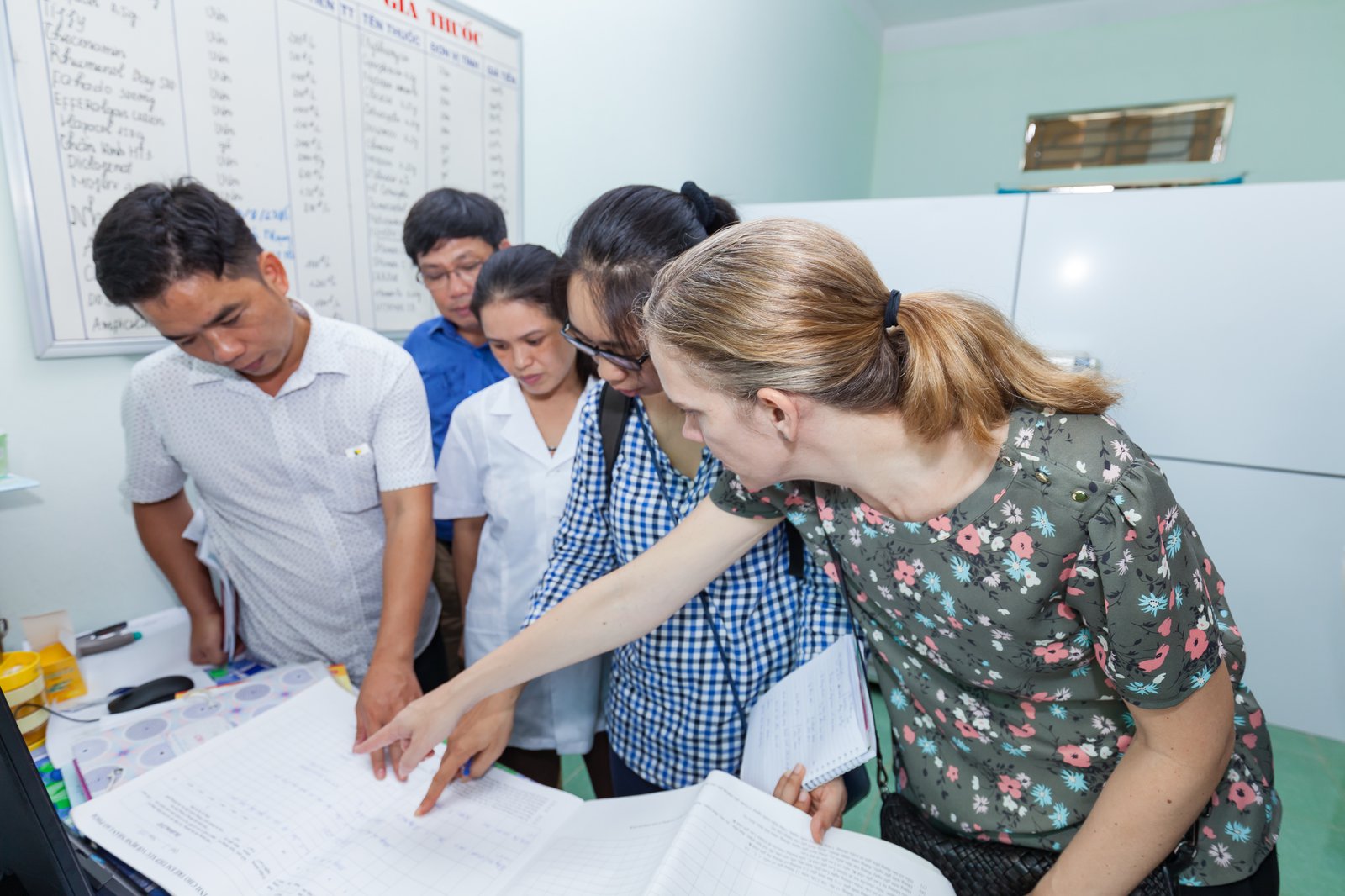In Vietnam’s Nghe An Province, the number of children diagnosed with tuberculosis (TB) has jumped precipitously in the past year and a half.
That sounds like a problem. But it’s actually a solution.
In Vietnam, about 90 percent of new childhood TB cases go undetected every year. As a result, tens of thousands of children suffer unnecessarily, and the infection is left to spread.
In 2016, PATH joined with Johnson & Johnson to implement Breath for Life, a model to improve prevention, detection, treatment, and management of pediatric TB in Vietnam, starting in Nghe An, a province with an especially high incidence of both TB and HIV.

Staff from Johnson & Johnson and PATH provide supportive supervision and on-the-job coaching in TB management at a local health center in Nghe An province.
Turning the tide of childhood TB
TB is a leading cause of illness worldwide and the World Health Organization ranks Vietnam as the 15th highest TB-burden country in the world. While TB is preventable and treatable, it is the leading killer among infectious diseases in Vietnam, largely due to low detection rates. It spreads rapidly through coughing, sneezing, and even breathing.
For children, the outlook is worse. TB is more difficult to detect in children and progresses more quickly. While a treatment called isoniazid preventive therapy (IPT) can reduce disease risk among children younger than 5 years, few local health workers know about IPT and many at-risk children therefore lack access.
Breath for Life is filling this gap, starting with a two-year pilot in four districts of Nghe An that is strengthening the capacity of public and private health care workers to diagnose, manage, and treat the disease. Working in partnership with Vietnam’s National TB Control Program and the Nghe An Provincial Health Department, the Breath for Life model supports systematic screening of all children who have had contact with adults diagnosed with TB, increasing the odds that affected kids get treated early.
- In its first year, Breath for Life doubled the number of children diagnosed with TB in the pilot districts.
- In less than two years, the number of eligible children in the pilot districts enrolled in IPT increased almost 500 percent—from 49 in 2015 to 244 by September 2017.

After taking part in Breath for Life, community health workers are better equipped to talk to their communities about how to detect, prevent, and manage TB, which can be a sensitive subject.
A groundbreaking partnership
Breath for Life is innovative—and so is the partnership behind it.
“For Breath for Life, Johnson & Johnson and PATH chose to work together through a meaningful partnership,” says Dr. Kimberly Green, PATH’s program director for Mekong Regional Program. “We built from our shared values in public health access and equity to co-create a pediatric TB initiative that drew on the strengths of both agencies and resulted in transformative change in childhood TB detection, treatment and prevention.”
For PATH, these strengths include a 40-plus year track record of global public health successes, along with strong relationships with government, the private sector, and civil society organizations in Vietnam. Johnson & Johnson brought its expertise in TB treatment (in 2012, the company introduced the first novel TB drug in the United States in more than 40 years), along with a longstanding commitment to advancing health for humanity around the globe. As a result, Breath for Life’s clear impact has led to keen commitments from the government to use the techniques and lessons learned during the project to strengthen childhood TB strategies across the country.
Dr. Nguyen Viet Nhung, director of Vietnam’s National Lung Hospital and manager of the National TB Control Program, is anxious to roll out Breath for Life more widely. “When we see a good example [of improved diagnosis and care], we have to replicate it as quickly as possible,” he says. “And this model is what I consider a good example.”

The Breath for Life team works with district hospitals to improve pediatric TB detection and diagnosis, and referral to specialist units.
Protecting a generation
It’s one thing to talk about training health workers to improve diagnosis and care, but seeing the effect Breath for Life is having on families’ lives is extraordinary.
Meet Mr. Phuong, a 58-year-old grandfather who was diagnosed with TB in June 2016—just a month after Breath for Life trained Dr. Tran Huu Thu and other doctors in Dien Chau District of Nghe An Province, where Mr. Phuong lives.
Mr. Phuong lives next door to his grandchildren and often cares for them while their parents are at work, so Dr. Thu made sure the children were screened for TB, and he counseled Mr. Phuong about how to reduce the risk of transmission. With help from local health workers, two of Mr. Phuong’s three grandchildren started IPT as a preventive measure. The third, who at 8 years old is too old to be eligible for IPT, is being closely watched for symptoms by his family, who were trained by local health workers in what to look for.

Dr. Thu counseled Mr. Phuong about his TB diagnosis and worked with him to identify any children in his household that are at risk of infection.
In 2015, no children in Mr. Phuong’s district were enrolled in preventive therapy. Less than two years later, 79 percent of the district’s children known to have had contact with a TB patient are getting preventive therapy.
For these children, Breath for Life is a barrier between them and a disabling—and, too often, deadly—disease. If it can be replicated nationwide, the model could help eradicate TB in Vietnam, unlocking potential and opening doors to opportunity for generations to come.
Learn more about our work on tuberculosis
Learn more about our work in Vietnam



